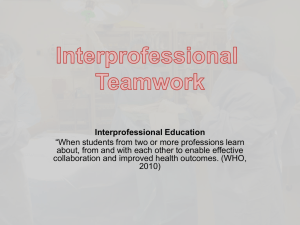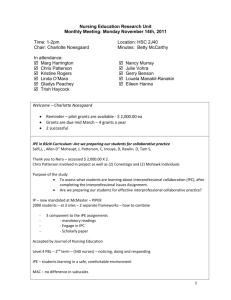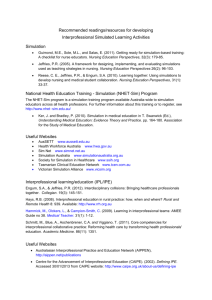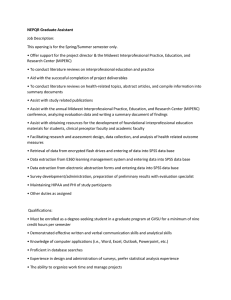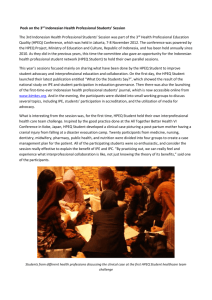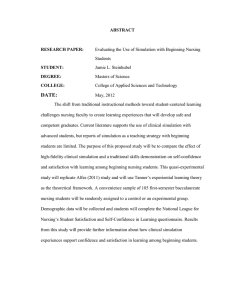Interprofessional competencies learned utilizing simulation as an innovative strategy with
advertisement
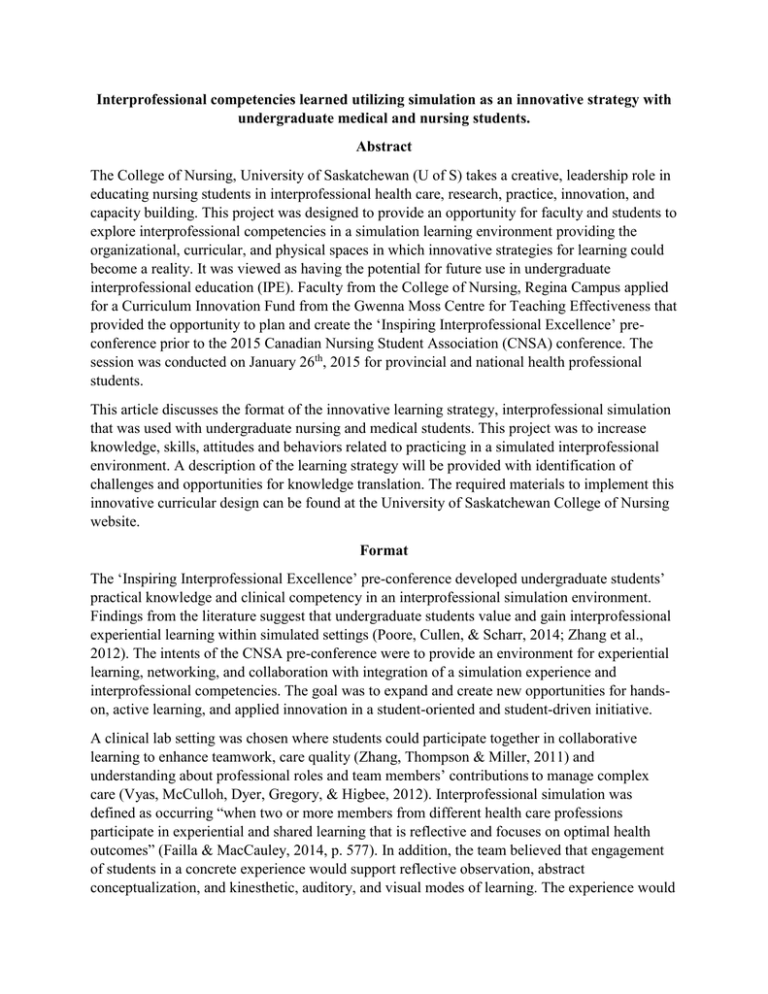
Interprofessional competencies learned utilizing simulation as an innovative strategy with undergraduate medical and nursing students. Abstract The College of Nursing, University of Saskatchewan (U of S) takes a creative, leadership role in educating nursing students in interprofessional health care, research, practice, innovation, and capacity building. This project was designed to provide an opportunity for faculty and students to explore interprofessional competencies in a simulation learning environment providing the organizational, curricular, and physical spaces in which innovative strategies for learning could become a reality. It was viewed as having the potential for future use in undergraduate interprofessional education (IPE). Faculty from the College of Nursing, Regina Campus applied for a Curriculum Innovation Fund from the Gwenna Moss Centre for Teaching Effectiveness that provided the opportunity to plan and create the ‘Inspiring Interprofessional Excellence’ preconference prior to the 2015 Canadian Nursing Student Association (CNSA) conference. The session was conducted on January 26th, 2015 for provincial and national health professional students. This article discusses the format of the innovative learning strategy, interprofessional simulation that was used with undergraduate nursing and medical students. This project was to increase knowledge, skills, attitudes and behaviors related to practicing in a simulated interprofessional environment. A description of the learning strategy will be provided with identification of challenges and opportunities for knowledge translation. The required materials to implement this innovative curricular design can be found at the University of Saskatchewan College of Nursing website. Format The ‘Inspiring Interprofessional Excellence’ pre-conference developed undergraduate students’ practical knowledge and clinical competency in an interprofessional simulation environment. Findings from the literature suggest that undergraduate students value and gain interprofessional experiential learning within simulated settings (Poore, Cullen, & Scharr, 2014; Zhang et al., 2012). The intents of the CNSA pre-conference were to provide an environment for experiential learning, networking, and collaboration with integration of a simulation experience and interprofessional competencies. The goal was to expand and create new opportunities for handson, active learning, and applied innovation in a student-oriented and student-driven initiative. A clinical lab setting was chosen where students could participate together in collaborative learning to enhance teamwork, care quality (Zhang, Thompson & Miller, 2011) and understanding about professional roles and team members’ contributions to manage complex care (Vyas, McCulloh, Dyer, Gregory, & Higbee, 2012). Interprofessional simulation was defined as occurring “when two or more members from different health care professions participate in experiential and shared learning that is reflective and focuses on optimal health outcomes” (Failla & MacCauley, 2014, p. 577). In addition, the team believed that engagement of students in a concrete experience would support reflective observation, abstract conceptualization, and kinesthetic, auditory, and visual modes of learning. The experience would provide students with an opportunity to review their feelings, performance, and outcomes during the pre-reflection and debriefing process regarding their current and future practice (Harder, 2010; Popil, 2011; Rudolph, Simon, Dufresne, & Raemer, 2006; Rushforth, 2007; Tilzer, Swenty, & Hoehn, 2012). The purpose of this project was to increase knowledge, skills, attitudes and behaviors related to practicing in a simulated interprofessional environment. The preconference was guided by experienced and competent health care facilitators and began with a pre-briefing session that included an outline of the simulation environment and learning objectives for the experience, description of the rubric to guide experiential learning focused on interprofesional competencies, consent forms, and the division of the students into interprofessional teams (see Appendix A). The use of Socrative app by MasteryConnect (see Appendix B) allowed for the assessment of prior knowledge and identified where gaps in information existed with each student in the different disciplines and parts of Canada. Following the introduction, the pilot project team lead the students to the simulation area where a demonstration of prebriefing, a simulation scenario, and debriefing occurred. The students were able to be active participants a comfortable and safe atmosphere. Interprofessional simulation scenarios were provided to teams by a designated faculty member and these timed clinical simulation scenarios unfolded through a ‘friendly’ competitive environment, following this the group evaluated the experience (see Appendix C). The SimWar initiative was conceptualized to provide a challenging competitive environment for the students as they were divided into teams with progression through scenarios thus accumulating points based on attainment of IPE competencies. This type of completion has been successful with student learning focusing on the resuscitation of patients in the United States and Canada (Dagnone, Takhar, & Lacroix, 2012; Okuda, Godwin, Westenbarger, & Shen, 2009). The team of students consisted of undergraduate students, 1 medical and 2 nursing students, as well as a IPE facilitator. The teams competed against one another in the constructed scenario of COPD exacerbation while ensuring interprofessional competencies were maintained in the provision of care during the management of a medium fidelity simulated patient. Following the simulation experience, a period of debriefing occurred where the group discussed the SimWar passport (see Appendix D) and assessed individual and team performance. The SimWar combined with an innovative interprofessional simulation experience allowed for the group to come together in the learning engaging in social interaction that ensured knowledge translation. This debriefing and evaluation period were designed with the theoretical tenets within Pro-Action Café. The Po-Action café is a method where groups interact to share ideas related to a project. It is an active method for conversation regarding projects to increase knowledge or processes (Proust, n.d.). Students’ experiential learning, through social interaction and reflective methods foster a positive attitude to collaboration (Reese, Jeffries, & Engum, 2010; Vyas et al., 2012), improved communications for care decision-making (Gough, Hellaby, MacKinnon, & Jones, 2012) and ‘enhanced knowledge, skills, confidence and competence’ for interprofessional team engagement (Efstathiou, Walker, & Marina, 2014; Gough et al., 2012). The SimWar passport contained an evaluative rubric, used to summarize the simulation performance levels and a team-scoring template was used to evaluate team performance. The teams resumed in the afternoon by beginning a construction of their own scenario for the interprofessional simulation and SimWar. The skeleton of the scenario (see Appendix C) was provided to the student teams and they were provided resources such as the National Interprofessional Competency Framework (2010), on-line resources such as IPE or simulation materials, and the facilitator. Students were encouraged to be creative and utilize principles of experiential learning to challenge the other teams with their invented and adapted scenarios. The teams then exchanged the simulations with each other and participated in another interprofessional simulation or SimWar. The facilitators assigned to each group observed the development of the scenarios concentrating on the team collaboration and communication to determine the points accumulated utilizing the SimWar Passport. The pilot project team then selected a winning team that was announced at the CASN conference banquet. Target Audience While faculty were planning and delivering this initiative for the CNSA pre-conference session, it was decided that students from two or more health professions would be invited to participate in the interprofessional simulation experience. The initial plan for the simulation experience was to invite six nursing students from across Canada attending the CASN conference, with an interprofessional complement of six medical students and six pharmacy students from the University of Saskatchewan. Additional support for planning and implementing the preconference was sought through undergraduate and graduate nursing students and additional College of Nursing staff to assist faculty to build capacity for research and knowledge translation activities. Although the team kept the key intents as a priority when planning the session, changes regarding the composition of the student teams were made due to some unforeseen challenges with recruitment of other health care professional students and faculty. In the final stages the total number of students was 9 with each team consisting of 2 nursing student and 1 medical student. Objectives The initial key intents for the pre-conference were to foster interprofessional collaboration, build community capacity, and design an innovative instructional strategy that could be incorporated into the undergraduate curriculum (see Appendix E). Specific learning outcomes were designed by the pre-conference team for learning specific to the interprofessional competencies and participating health care professionals. The learning objectives focused on knowledge, skills, attitudes and behaviors. Assessment In the planning stages, the team discussed the attainment of affective, cognitive and psychomotor skills would be assessed utilizing a social interaction knowledge translation (KT) approach. This type of approach with ‘how to’ work together (Jansen, McWilliam, Forbes & Forchuk, 2013) within inter-professional teams could assist with increasing knowledge. For example, the team discussed how authentic educational opportunities for undergraduate and graduate students create desirable learning contexts as a key component of effective education (Goldenberg, Andrusyszyn, & Iwasiw, 2005). The specific use of social interaction would be in reflection and debriefing focusing on how learning occurred for the team participants, what participant reflections or feelings were, and how the simulation and/or debriefing exercises promoted their collaborative learning. Social interaction (see Appendix F) combined with the rubric in the SimWar passport provided the assessment and evaluation of learning objectives. Evaluation Following the completion of the simulation scenarios, a Pro-Action Café method (Fay & Cooke, 2012) was used to promote social interaction, define KT, and evaluate the effectiveness of the interprofessional simulation. The SimWar passport was completed within each group, providing evaluation within the debriefing component to identify areas of strength and necessary improvements in practice. The teams were then divided into two larger groups. Building on the social interaction approaches enacted within the passport exercise, the students participated in three conversation rounds to share and reflect on knowledge about how learning may have transpired to address the benefits/opportunities and challenges of the two events. The questions discussed were: What was learned throughout the day? Was there anything missing from the knowledge gained? Could things have been different? How will the new knowledge impact practice or learning in the future? What are the next steps? Each group of students provided written and verbal evaluation and came to an agreement with the co-creation of statements reflecting learning and further enhancement of IPE. The student groups then exchanged rooms to reflect and discuss their perspectives on benefits and challenges with the outcome for knowledge translation. Students were encouraged to discuss strategies for implementation of IPE initiatives in future curricula planning. Following the third round, the facilitators collated the results of the teams’ dialogue. The following themes for each question were identified: Question 1-What was learned throughout the day? The importance of role clarification and understanding others roles emerged as a paramount theme. Additional themes identified were the importance of debriefing after the simulation and involving the patient and family in the care, advocating for the patient, leadership roles within the team, as well as communication between the students. Students also noted that they learned how to clarify and understand the rationales of each healthcare professional’s decisions regarding the next steps in patient care. Students indicated that the use of a demonstration scenario allowed them to visualize the interprofessional collaboration and coordination between health care professionals. A quote from one of the students during the debriefing sums up many of the points during this discussion, “new knowledge can lead to an increase in teamwork and comfort with disciplines and can decrease fragmentation of health provisions.” Question 2-Was there anything missing from the knowledge gained? Could things have been different? The main theme noted was that familiarity with each profession and the environment may have improved the experience. There was discussion regarding involving other professions in the interprofessional simulation to enhance the interdisciplinary context. One student believed that a discussion regarding the perceptions of other professions in the informational session would have been beneficial. The students also discussed the fact that having various health care backgrounds led to some degree of difficulty during the simulation initiative. For example, the students in each group required an orientation to basic equipment utilized in the simulation lab at the Regina Campus. Students possessed some knowledge regarding the use of the medium fidelity mannequins. Individual students had the opportunity to learn about the nursing programs throughout the country and the medical program here in Saskatchewan. Impact The final question discussed during the Pro-Action Café related to the impact of the learning activity and what the students’ next steps for implementing the knowledge, skills, attitudes and behaviors gained during the activity could be ingrained into practice. Question 3-How will the new knowledge impact practice or learning in the future? What are the next steps? The students had numerous ideas on how they would implement this new knowledge in their future student experiences and professional lives. They planned to implement the communication skills and organization they learned throughout the interprofessional simulation, as well as the holistic and patient centered care they experienced. The students expressed that they would practice these skills in their practice and in their studies. Many students pointed out the importance of “knowing what you don’t know”, and finding the resources to find out. The students found the activity made them more comfortable sharing knowledge between professions, gave them confidence to stand up for themselves and the knowledge they possess, and that the different strengths of various health care professionals involved in patient care can be utilized to effectively care for the patient. The students also identified that individual contributions are important and that more knowledge will lead to an increase in positive outcomes for patients. At a follow-up meeting, the planning team discussed how this initiative could inform the College of Nursing’s strategic plan for future curriculum revisions, innovative instructional strategies, and planned knowledge translation. An ‘enhancement approach’ to IPE (Deutschlander, Suter & Lait, 2012) suggests that gradual introduction of experiential learning strategies such as workshops within existing uni-disciplinary clinical placements not only decreases resource allocation required for IPE but also promotes broad-based and sustainable interprofessional initiatives. Findings from a pilot study that used clinical simulation scenarios to promote collaborative teamwork (Wagner, Liston, & Miller, 2011) supported implementation of smaller scale IPE and suggested that medical and nursing students valued interactive experiential approaches to foster working together. One idea was to have a curriculum forum where students and faculty have the opportunity to discuss and apply social interaction strategies for the translation of experiential- and research-informed IPE simulation knowledge. The interprofessional context brings a provincial and global sense of place to teaching and learning spaces with students sharing their unique perspectives, experiences, and expertise. Faculty will need to be given the opportunity for professional development to enhance their skills in delivering interprofessional simulation experiences for students in all years of the program. Further work is needed to inform educators about educational models and the creation of innovative social interaction strategies that constitute experiential enactment of knowledge (Jansen et al., 2013) within interprofessional teams. Specifically, the social interaction knowledge transfer (KT) theory of Translating Knowledge Through Relating (Jansen et al., 2012) suggests relational interactions, reflective learning, and sharing of experiential ‘how to’ knowledge with students may promote evidence-based KT strategies for IPE. Creative evaluative tools are also needed for assessment of student learning from the cognitive, affective, and psychomotor domains. Required Materials Throughout the pilot project faculty, staff and students utilized campus collaboration as a resource to plan effective strategies for implementation. The required materials related to this strategy can be located at http://www.usask.ca/nursing/interprofessional/simulation.php . The University of Saskatchewan College of Nursing has a Simulation Centre on campus that provided the environment necessary for simulation and space for the three groups of students. The simulation scenarios were based on the use of current mannequins with medium fidelity attributes. This could be adapted for local resources to include high-fidelity mannequins or live actors to provide realism. Additional materials required are specific to the respiratory or cardiac scenario (see Appendix G). Conclusion Overall, the CSNA pre-conference event created an ideal opportunity for interprofessional simulation and development of skills utilizing simulation, debriefing, and knowledge translation. The students were excited to learn and the event challenged their thinking in regards to what they already knew, assisting them to discover new concepts, ideas, and rationale for collaborative professional practice. The literature suggests that improved healthcare outcomes are achieved when interprofessional care providers learn how to function as a team by working closely with each other (Canadian Interprofessional Health Collaborative, 2010; Vyas et al., 2012). The creative use of an interprofessional simulation, the SimWar, and Pro Action Café from a team of diverse backgrounds and experiences assisted with learning, innovation, and new discovery. In summary, this innovative learning strategy provided an incremental approach to IPE that may promote the success of practical and interactive simulation strategies in the undergraduate curriculum. The social interactions completed in the pilot project contrast with traditional educational approaches of didactic information transfer and offer an understanding about how KT is co-facilitated as a mutual process among interprofessional team members and students. Faculty at the College of Nursing, U of S is committed to involving students in applied work and learning that leads to better student engagement and better client outcomes. References Canadian Interprofessional Health Collaborative. (2010). A national interprofessional competency framework. Vancouver, BC: College of Health Disciplines. Retrieved from http://www.cihc.ca/files/CIHC_IPCompetencies_Feb1210.pdf College of Nursing. (2011). Information about the College. Retrieved from http://www.usask.ca/nursing/college Dagnone, J. D., Takhar, A., & Lacroix, L. (2012). The simulation Olympics: A resuscitationbased simulation competition as an educational intervention. Canadian Journal of Emergency Medicine, 14(6), 363 – 368. Deutschlander, S., Suter, E., & Lait, J. (2012). Models in interprofessional education: The IP enhancement approach as effective alternative. Work, 41(3), 253-60. doi: 10.3233/WOR-20121293 Efstathiou, N., & Walker, W. M. (2014). Interprofessional, simulation-based training in end of life care communication: A pilot study. Journal of Interprofessional Care, 28(1), 68-70. doi: 10.3109/13561820.2013.827163 Failla, K.R., Macauley, K. (2014). Interprofessional simulation: A concept analysis. Clinical Simulation in Nursing, 10(11), 574-580, doi: http://dx.doi.org/10.1016/j.ecns.2014.07.006 Cook, S. & Fay, S. (2012). Enriching Your Projects Through Collaboration: Using a Pro-Action Café to Facilitate Effective Sharing, Learning and Collaborating in Research on Aging. Nova Scotia conference on aging. Retrieved from: http://www.msvu.ca/en/home/community/Centres_Institutes/centreonaging/agingconference/defa ult.aspx. Goldenberg, D., Andrusyszyn, M. A., & Iwasiw, C. (2005). The effect of classroom simulation on nursing students' self-efficacy related to health teaching. The Journal of Nursing Education, 44(7), 310-314. Gough, S., Hellaby, M., Jones, N., & MacKinnon, R. (2012). A review of undergraduate interprofessional simulation-based education (IPSE). Collegian, 19, 153-170. Harder, B. N. (2010). Use of simulation in teaching and learning in health sciences: A systematic review. The Journal of Nursing Education, 49(1), 23-28. doi: 10.3928/01484834-20090828-08 Impact. The Co-operators Youth Program for Sustainability Leadership. (2014). What is ProAction Café? Retrieved from http://www.impactyouthsustainability.ca/blogs/recentnews/what_is_proaction_cafe Jansen, L., McWilliam, C. L., Forbes, D., & Forchuk, C. (2013). Social-interaction knowledge translation for in-home management of urinary incontinence and chronic care. Canadian Journal of Aging, 32(4), 392-404. Murdoch, N. L., Bottorff, J. L., & McCullough, D. (2014). Simulation education approaches to enhance collaborative healthcare: A best practices review. International Journal of Nursing Education Scholarship, 10(1), 307-321. Okuda, Y., Godwin, A., Westenbarger, R., & Shen, B. (2009). “Sim wars”: A new edge to academic residency competitions. Academic Emergency Medicine, 16: S275–S276. doi: 10.1111/j.1553-2712.2009.00392_4.x Poore, J. A., Cullen, D. L., & Schaar, G. L. (2014). Simulation-based interprofessional education guided by Kolb's experiential learning theory. Clinical Simulation in Nursing, 10(5), e241-e247. doi: http://dx.doi.org/10.1016/j.ecns.2014.01.004 Popil, I. (2011). Promotion of critical thinking by using case studies as teaching method. Nurse Education Today, 31(2), 204-207. Proust, M. (n.d.). The Pro Action Café version 1.2. Retrieved from http://www.theworldcafecommunity.org/forum/topics/pro-action-cafe Reese, C. E., Jeffries, P. R., & Engum, S. A. (2010). Learning together: Using simulations to develop nursing and medical student collaboration. Nursing Education Perspectives, 31(1), 3337. Rudolph, J.W., Simon, R., Dufresne, R.L., & Raemer, D. (2006). There is no such thing as “nonjudgemental” debriefing: A theory and method for debriefing with good judgment. Simulation in Health Care, 1(1), 49-55. Rushforth, H. E. (2007). Objective structured clinical examination (OSCE): Review of literature and implications for nursing education. Nurse Education Today, 27(5), 481-490. Sharma, S., Boet, S., Kitto, S., & Reeves, S. (2011). Interprofessional simulated learning: The need for 'sociological fidelity'. Journal of Interprofessional Care, 25(2), 81-83. doi: 10.3109/13561820.2011.556514 Tilzer, L., Swenty, C., & Hoehn, W. G. (2012). An interprofessional simulation promoting collaboration and problem solving among nursing and allied health professional students. Clinical Simulation in Nursing, 8(8), 325-333. doi: 10.1016/j.ecns.2011.01.001 University of Saskatchewan. (2012). Promise and potential: The third integrated plan. Retrieved from www.usask.ca/plan/documents/Third%20Integrated%20Plan%20 %20Summary%20Version.pdf Vyas, D., McCulloh, R., Dyer, C., Gregory, G., & Higbee, D. (2012). An interprofessional course using human patient simulation to teach patient safety and teamwork skills. American Journal of Pharmaceutical Education, 76(4), 71. doi: 10.5688/ajpe76471 Wagner, J., Liston, B., Miller, J. (2011). Interprofessional communication skills. Teaching and Learning in Nursing, 6(3), 97-101. Willhaus, J. (2012). Headlines from the NLN: Working toward interprofessional education with simulation. Nursing Education Perspectives, 33(2), 134. Zhang, C., Thompson, S., & Miller, C. (2011). A review of simulation-based interprofessional education. Clinical Simulation in Nursing, 7(4), e117-e126.
